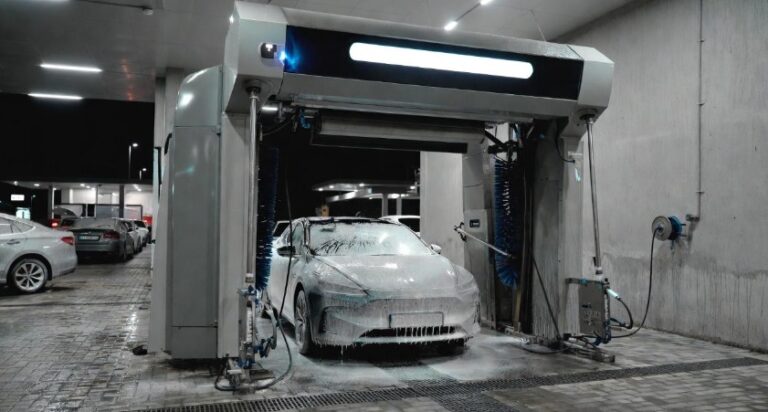Illinois Window Tinting Laws [Updated, 2025] – Everything You Must Know Before You Tint
![Illinois Window Tinting Laws [Updated, 2025] – Everything You Must Know Before You Tint 1 Illinois Window Tinting Laws [Updated, 2025] – Everything You Must Know Before You Tint](https://aautomotives.com/wp-content/uploads/2025/10/Illinois-Window-Tinting-Laws-Updated-2025-–-Everything-You-Must-Know-Before-You-Tint.jpg)
If you’ve ever driven through Illinois on a bright summer day, you’ve probably noticed how many cars have tinted windows. They look sleek, help keep out the blazing sun, and offer some privacy. But here’s the catch — Illinois isn’t casual about window tinting. The Illinois window tinting laws are some of the most specific in the country, and not knowing them could lead to unexpected fines or even a court date.
Back in 2009, Illinois laid out strict rules on how dark or reflective your car’s tint can be. Since then, those laws have seen a few small updates — and in 2025, it’s more important than ever to understand what’s legal and what’s not. Think of this guide as your friendly co-pilot, walking you through every rule, exception, and penalty related to Illinois window tint laws.
So, before you roll into the nearest tint shop, let’s break it all down — from VLT percentages to medical exemptions — in a way that actually makes sense.
In This Article
- 1 Understanding the Basics: What Is Window Tinting, Really?
- 2 Legal Window Tint Darkness in Illinois (VLT Rules)
- 3 Why These Percentages Matter
- 4 Special Tint Rules That Many Drivers Miss
- 5 Legal Window Tint Reflection in Illinois (VLR Rules)
- 6 Other Key Illinois Tinting Rules You Shouldn’t Ignore
- 7 The Real-Life Cost of Ignoring Tint Laws
- 8 Why Following Illinois Window Tinting Laws Actually Pays Off
- 9 Common Myths About Window Tinting in Illinois
- 10 Tips for Choosing the Right Tint for Your Vehicle in Illinois
- 11 Common Questions About Illinois Window Tinting
- 12 How to Stay Compliant Without Sacrificing Style
- 13 Summary: Why Understanding Illinois Window Tinting Laws Matters
- 14 Final Thoughts
- 15 FAQs Recap
Understanding the Basics: What Is Window Tinting, Really?
Window tinting might sound like just a cosmetic upgrade, but it’s more than that. It’s a thin film applied to your car’s glass that reduces the amount of sunlight and UV rays that pass through. Think of it as sunglasses for your car. It helps keep your car cooler, protects your upholstery, and gives a sense of privacy — but too dark, and you might find yourself on the wrong side of Illinois law.
Illinois defines window tinting using two key terms — Visible Light Transmission (VLT) and Visible Light Reflection (VLR). These two factors determine how much light your windows let in and how much they reflect out.
-
VLT (Visible Light Transmission): The percentage of light that passes through your car’s windows. A higher VLT means more light enters the vehicle.
-
VLR (Visible Light Reflection): The percentage of light that bounces off your car’s windows. A lower VLR keeps reflections down, helping avoid glare for other drivers.
Understanding these two measurements is crucial because Illinois window tint laws are based entirely on them.
Legal Window Tint Darkness in Illinois (VLT Rules)
When it comes to how dark you can go, Illinois has a clear system. The laws differ depending on whether your vehicle is a passenger car (sedan) or a multi-purpose vehicle (SUV or van).
Let’s look at both categories:
For Passenger Vehicles (Sedans):
| Window | Legal Tint Darkness | Notes |
|---|---|---|
| Windshield | Non-reflective tint allowed on top 6 inches | Keeps glare away without blocking vision |
| Front Side Windows | Up to 35% tint darkness | Must allow 35% of light through |
| Back Side Windows | Up to 35% tint darkness | Same limit as front |
| Rear Window | Up to 35% tint darkness | Rearview mirror visibility must remain clear |
For Multi-Purpose Vehicles (SUVs and Vans):
| Window | Legal Tint Darkness | Notes |
|---|---|---|
| Windshield | Non-reflective tint allowed on top 6 inches | Same as sedans |
| Front Side Windows | Up to 50% tint darkness | Allows more light in |
| Back Side Windows | Any darkness allowed | Flexible for privacy and glare control |
| Rear Window | Any darkness allowed | Maximum freedom for back window tinting |
These differences exist because SUVs and vans often carry cargo or passengers in the back — where visibility is less crucial for driving safety. Sedans, however, are subject to stricter rules since the driver’s field of vision is more dependent on side and rear visibility.
Why These Percentages Matter
If you’re wondering, “Why not just go as dark as I want?”, here’s the deal — law enforcement visibility. Police officers must be able to see inside your vehicle during a traffic stop for safety reasons. Too dark a tint can make that difficult, raising concerns about concealment and safety.
On top of that, darker tints can reduce visibility for the driver during nighttime or low-light conditions. Illinois law aims to strike a balance — allowing comfort and UV protection while keeping visibility and safety in check.
So while 20% tint might look cool, it could easily get you a citation in Illinois. Always check the VLT percentage before installing new window film, and make sure it complies with state limits.
Special Tint Rules That Many Drivers Miss
Illinois tinting laws go beyond just percentages. The rules also consider combinations of front and rear tint levels — and these can get a little confusing. Here’s a quick breakdown:
-
If all side and rear windows are tinted, no tint darker than 35% VLT is allowed anywhere.
-
If no tint is applied behind the driver, the front side windows may have up to 50% light transmission.
-
If factory tint is already installed on rear windows, your front side windows must allow more than 50% light transmission.
What this means is, your tint must not just meet individual window rules — it has to balance with the overall tint setup of the car.
Failing to do this could lead to a ticket, and yes — Illinois law enforcement does check these details carefully, especially during safety inspections or traffic stops.
Legal Window Tint Reflection in Illinois (VLR Rules)
While darkness is one part of the story, reflection is another. The Visible Light Reflection (VLR) rate determines how shiny or mirror-like your tint appears. Some tints reflect sunlight heavily, which can blind other drivers or cause distractions on the road.
Illinois keeps reflection limits simple — no reflective tints are allowed on passenger or multi-purpose vehicles.
Here’s the breakdown:
-
Front Side Windows (Sedans, SUVs, Vans): Must not be reflective.
-
Back Side Windows (Sedans, SUVs, Vans): Must not be reflective either.
So, if you’re tempted by metallic or mirror-style tints that look futuristic, you might want to skip them in Illinois. They might look cool under the sun, but they’ll also catch the attention of law enforcement — and not in a good way.
Other Key Illinois Tinting Rules You Shouldn’t Ignore
Beyond VLT and VLR, the Illinois window tinting laws include several smaller but equally important regulations. Missing these details can also get you fined, so let’s go through them one by one.
1. Side Mirrors:
If your rear window is tinted, you must have dual side mirrors. This ensures visibility of the road behind you even if your rear view is slightly obscured.
2. Restricted Colors:
Unlike some states, Illinois doesn’t restrict tint colors. You can choose from gray, black, bronze, or blue shades. Still, flashy or mirrored tints that reflect light are prohibited due to safety concerns.
3. Certificates and Stickers:
Some states require manufacturers to provide certification stickers that confirm the tint meets legal standards. Illinois does not require certificates or stickers. However, it’s still smart to keep your tint purchase receipt — it can help if you’re ever questioned about compliance.
4. Medical Exemptions:
Illinois understands that certain medical conditions (like lupus, photosensitivity, or skin cancer) require extra protection from sunlight. If you have a qualifying medical condition, you can apply for a medical exemption allowing darker tints. To get one, you’ll need a doctor’s note and official approval from the Illinois Secretary of State’s office.
5. Penalties for Breaking Tint Laws:
Violating the Illinois window tint laws can cost more than you think.
-
First offense: Petty violation, with fines ranging from $50 to $500.
-
Second or repeat offense: Class C misdemeanor, with fines between $100 and $500, and potential mandatory tint removal.
These fines may not sound huge, but they add up quickly — especially if you need to redo your tint. Not to mention, it can affect your vehicle inspection record, which can be frustrating if you’re selling your car later.
The Real-Life Cost of Ignoring Tint Laws
Imagine this — you get your car tinted in another state during a road trip because the shop there offers a great deal. You return home to Illinois feeling great about your new sleek look. A week later, you get pulled over, and the officer’s tint meter shows your front windows allow only 25% light through. You’re hit with a fine and told to remove the tint.
That small discount from another state’s tint shop suddenly doesn’t feel worth it anymore.
It happens more often than you think. Illinois has its own unique tint percentage rules, so what’s legal in Indiana or Wisconsin might be illegal once you cross back over the state line. Always check Illinois-specific laws before tinting — or even before buying a pre-tinted car.
Why Following Illinois Window Tinting Laws Actually Pays Off
Sure, nobody loves extra rules. But staying compliant actually benefits you in the long run. Here’s why:
-
Avoid Legal Hassles: No fines, no court appearances, no wasted time.
-
Insurance Compliance: Some insurance companies might deny claims if your tint is illegal and contributed to reduced visibility during an accident.
-
Better Safety: Legal tint levels still block UV rays and heat while keeping visibility intact.
-
Higher Resale Value: Cars that meet legal standards sell faster and avoid inspection issues.
If you look at it that way, following the Illinois window tinting laws isn’t a hassle — it’s a smart investment in safety and peace of mind.
Common Myths About Window Tinting in Illinois
Let’s clear up a few misconceptions that drivers often believe — and that can get them in trouble.
-
Myth #1: Factory tint means I can go darker.
Not true. Factory-installed tints already count toward the total VLT limit. Adding more film can make your tint illegal. -
Myth #2: Only front windows are checked by police.
Incorrect. Officers can and do check side and rear tints during stops. -
Myth #3: Medical exemptions mean unlimited tint.
Even medical exemptions have guidelines and documentation requirements. You can’t just install 5% tint without approval. -
Myth #4: Tint tickets don’t matter.
Actually, multiple violations can escalate from a fine to a misdemeanor — which stays on your record.
These myths circulate everywhere, but knowing the truth can save you hundreds of dollars — and unnecessary headaches.
Tips for Choosing the Right Tint for Your Vehicle in Illinois
Selecting the perfect tint isn’t just about aesthetics — it’s about safety, compliance, and comfort. When choosing a window tint, always consider VLT, VLR, and your vehicle type. Passenger cars need more conservative tints, while SUVs and vans offer more flexibility.
Here are a few tips to keep in mind:
-
Check the Laws Before Buying: Always verify the current Illinois window tint percentages for your specific vehicle type. Laws can update, so avoid assuming past knowledge still applies.
-
Avoid Excessively Dark Films: Dark tints may look stylish, but they’re more likely to draw police attention and could cause a ticket.
-
Choose Non-Reflective Films: Illinois strictly prohibits reflective tints. Stick with matte or standard films to stay safe.
-
Consider UV Protection: Some films offer higher UV protection while staying within legal VLT limits. This protects your skin and interior from sun damage.
-
Professional Installation: Proper installation ensures your tint adheres evenly and doesn’t bubble or peel, which could otherwise violate regulations indirectly.
Following these tips ensures your vehicle looks good while remaining fully compliant with Illinois law.
Common Questions About Illinois Window Tinting
Even after explaining the rules, drivers often have lingering questions. Here are answers to the most frequently asked questions about Illinois window tinting laws:
1. Can I tint my front windshield?
Yes, but only the top 6 inches can have non-reflective tint. Tinting the main portion of the windshield is illegal.
2. Are there color restrictions for tint?
No. Illinois does not restrict tint color, but reflective or mirrored finishes are prohibited.
3. Can I tint my rear windows darker than the front?
Yes. Passenger vehicles have limits on all windows, but multi-purpose vehicles can have any darkness on rear windows.
4. Are there medical exemptions?
Yes, Illinois allows medical exemptions for those with conditions that require extra sunlight protection. Documentation and approval are required.
5. What if I have factory-installed tint?
Factory tint counts toward your VLT limit. Front side windows may need a higher VLT if rear factory tint is darker than allowed.
6. Do I need stickers or certificates for my tint?
No. Illinois does not require certificates or stickers to prove legal tinting.
7. What are the penalties for breaking the law?
Fines can range from $50 to $500 for first-time offenses. Repeat violations are class C misdemeanors with fines between $100 and $500.
8. Do tinted side mirrors matter?
Yes. If your rear window is tinted, dual side mirrors are required for safety.
How to Stay Compliant Without Sacrificing Style
Many drivers worry that following the law means giving up their car’s look. Fortunately, there are ways to balance compliance with style:
-
Gradient Tints: Only tint the top portion of your windshield or windows to achieve a sleek look while remaining legal.
-
High-Quality Films: Invest in premium tints that maximize UV and heat reduction within legal limits.
-
Professional Consultation: A reputable tint shop will know the current Illinois laws and help you choose the right shade for both legality and aesthetics.
By carefully selecting your tint, you can enjoy privacy, UV protection, and a cooler cabin without risking penalties.
Summary: Why Understanding Illinois Window Tinting Laws Matters
The Illinois window tinting laws [Updated, 2025] may seem complicated at first, but understanding them protects you from fines, misdemeanor charges, and safety risks. Here’s a quick recap:
-
Passenger Vehicles: Max 35% tint on all windows except the top 6 inches of the windshield.
-
Multi-Purpose Vehicles: Up to 50% on front side windows, unlimited darkness on rear windows.
-
Non-Reflective Tints Only: Reflection is not allowed on any window.
-
Side Mirrors Required: If rear windows are tinted, dual side mirrors are mandatory.
-
Medical Exemptions: Available with proper documentation.
-
Penalties: Fines range from $50–$500, with repeat violations classified as misdemeanors.
Keeping your vehicle compliant ensures your safety, legality, and peace of mind. Remember, tinted windows are a luxury that comes with responsibility. A little research and attention to detail can prevent fines and keep your car looking stylish for years.
Final Thoughts
Tinting your vehicle’s windows is more than just an aesthetic choice — it’s a matter of safety, legal compliance, and personal comfort. Illinois has specific rules that balance privacy and protection with visibility and road safety. By understanding VLT, VLR, and all associated regulations, you can enjoy the benefits of tinting without risking penalties.
Think of it like this: your car’s windows are the eyes of your vehicle. The tint protects them from harsh sunlight while allowing them to see clearly. Follow the laws, make smart tint choices, and your ride will stay safe, legal, and stylish.
FAQs Recap
Q1: Can I tint my front windshield fully?
A1: No, only the top 6 inches can have non-reflective tint.
Q2: Are there limits on tint color?
A2: No color restrictions, but reflective tints are banned.
Q3: Can SUV rear windows be fully tinted?
A3: Yes, multi-purpose vehicles have no limits on rear window darkness.
Q4: Is a medical exemption possible?
A4: Yes, with proper documentation and approval.
Q5: Are certificates or stickers required?
A5: No, but keeping receipts can help if questioned.
Q6: What if I have factory-installed tint?
A6: Front side windows may require higher VLT to balance the factory tint.
Q7: What are the penalties for violating tint laws?
A7: Fines $50–$500; repeat violations are class C misdemeanors.
Q8: Are side mirrors required with rear tint?
A8: Yes, dual side mirrors are mandatory if the rear window is tinted.
By following these guidelines, you can confidently navigate Illinois tint laws and enjoy a safer, cooler, and stylish drive.






